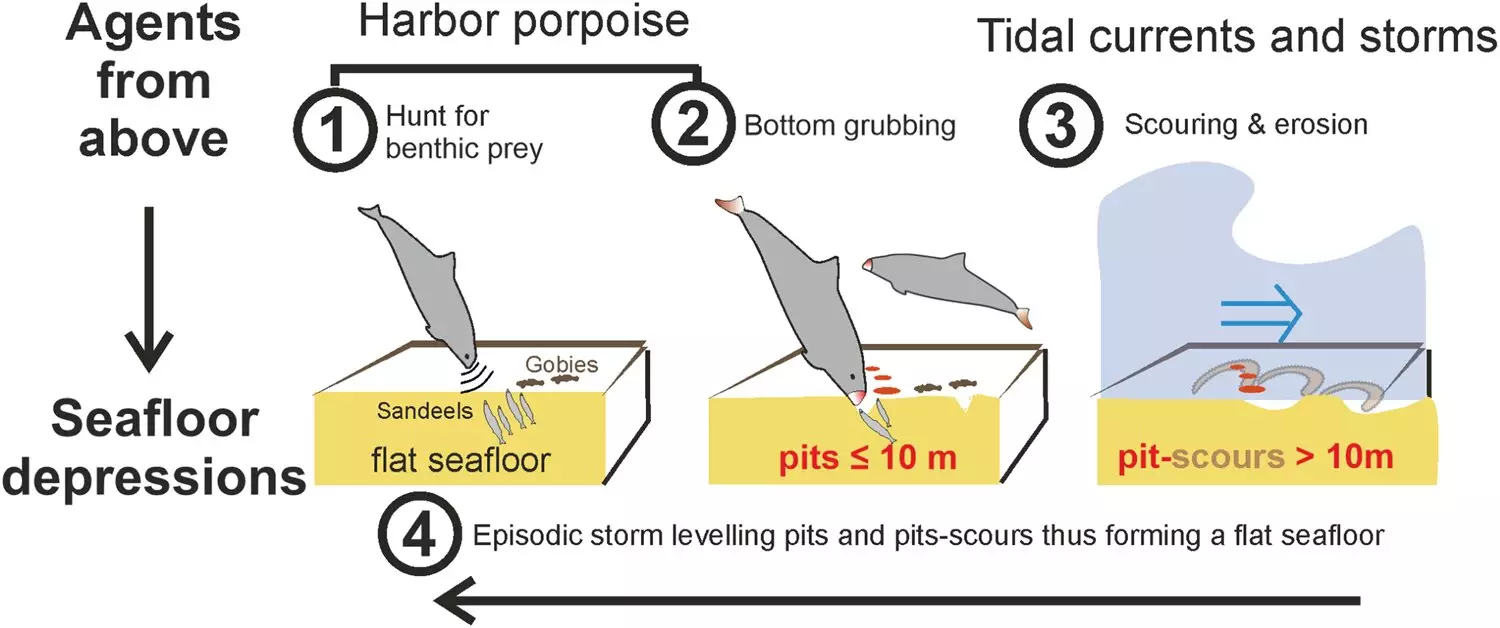

The world’s oceans are home to an incredible array of organisms that not only inhabit the seafloor but also have a significant impact on shaping its structure. Despite this, the precise mechanisms by which marine life influences seafloor formation have remained largely unexplored. However, a recent interdisciplinary study conducted by geoscientists from Kiel University, in collaboration with researchers from biology and oceanography, has shed new light on this complex relationship. By examining crater-like depressions on the floor of the North Sea, the team has revealed a direct correlation between these features and the habitats of porpoises and sand eels. This groundbreaking research provides a comprehensive explanation for the significant role that vertebrates play in shaping the seafloor.
The North Sea seafloor is punctuated by thousands of crater-like depressions known as pockmarks, which are also found in oceans around the world. These formations have traditionally been attributed to fluid discharge, such as methane or groundwater seepage. However, many of these pockmarks have remained inexplicable. The study conducted by the Kiel University team challenges the prevailing understanding and demonstrates that these depressions are not formed by rising fluids but are instead directly linked to the presence of porpoises and sand eels.
To investigate seafloor depressions in the North Sea, the researchers meticulously examined the seafloor off Heligoland and analyzed the behavior of marine animals, particularly porpoises. Their research suggests that most of the depressions in the German Bight are created by porpoises and other creatures in search of food. The sand eel, a small fish that spends much of its time buried in sediment, plays a vital role in this process. Notably, sand eels are a crucial food source for the North Sea porpoise population. By examining the stomach contents of stranded porpoises, Dr. Anita Gilles from the TiHo-Institute for Terrestrial and Aquatic Wildlife Research found evidence supporting the importance of sand eels as a food source.
The discovery of shallow pits in the seafloor, similar in appearance to the well-known pockmarks, provided the researchers with an alternative explanation for the formation of these features. Using advanced multibeam echosounder technology, the team detected thousands of enigmatic pits with an average depth of just 11 centimeters. These pits differ in morphology from the more conical craters typically associated with pockmarks. Dr. Jens Schneider von Deimling, the lead author of the study, contends that these pits are not caused by rising fluids but are the result of porpoise feeding activities near sand eel habitats.
The key to the team’s groundbreaking findings was their interdisciplinary approach, combining geological studies, geophysical sonar measurements, vertebrate behavior and feeding biology, satellite evaluation, and oceanographic analysis. By meticulously analyzing millions of echosoundings, collected during extensive research vessel surveys, the researchers were able to identify and characterize the shallow pits. The use of modern methods facilitated the automatic detection and analysis of these structures within vast acoustic datasets, making this investigation possible.
The research team’s findings have profound implications at both a geological and biological level. The scouring of sediments by vertebrates in the ocean has the potential to shape the seafloor on a global scale and impact benthic ecosystems. In the study area alone, approximately 9% of the seafloor is covered by pits. Preliminary volume estimates suggest that over 773,369 tons of sediment have been deposited across an area of 1581 km², which is equivalent to the weight of half a million cars.
The comprehensive insights gained from this study have wider implications beyond the field of marine science. The research offers valuable information for assessing the ecological risks associated with the expansion of renewable energies in the offshore sector, thereby supporting efforts to improve marine environmental protection. By better understanding the complex relationship between marine life and seafloor formation, scientists and policymakers can make more informed decisions regarding ocean management and conservation.
The investigation into the connection between marine life and seafloor formation is still in its infancy, but the recent study from Kiel University represents a significant step forward. By unraveling the relationship between porpoises, sand eels, and seafloor depressions, the research provides a compelling explanation for the mechanisms that shape the ocean floor. As further studies build upon these findings, our understanding of the intricate relationships within our oceans will continue to evolve, fostering a greater appreciation for the crucial role marine life plays in shaping our planet.
In the world of pharmaceuticals, innovation often hinges on finding new compounds that can lead…
In the heart of the Amazon basin, drastic climate changes present an alarming reality that…
Air fryers have rapidly surged in popularity, captivating home cooks and culinary enthusiasts alike. When…
In an era where technology and social media reign, the importance of sleep often takes…
In an era where environmental consciousness is paramount, the maritime industry has long been scrutinized…
Radionuclides, often relegated to discussions surrounding nuclear energy and radioactive waste, have far-ranging implications for…
This website uses cookies.